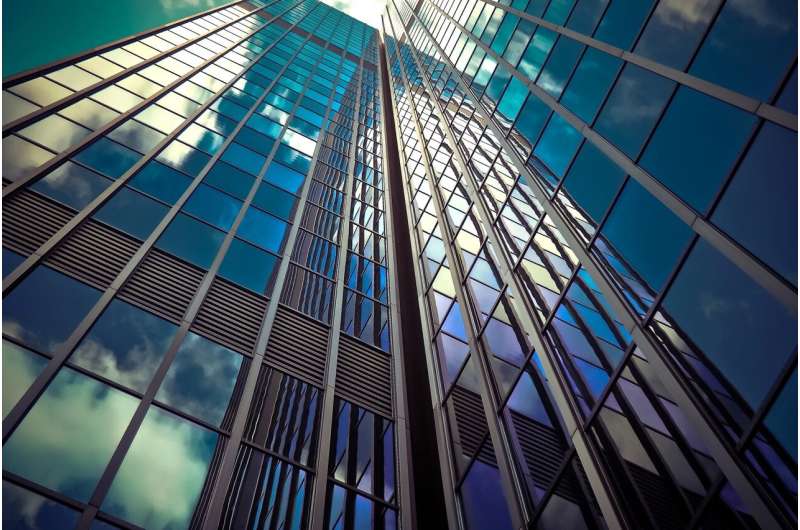Wasteful steel-and-glass buildings fuel global climate injustice, says climate expert

Architects, contractors, planners and construction clients must consider building projects from a moral standpoint based on their lifetime carbon impact, a leading design and climate expert has suggested.
David Coley, Professor of Zero Carbon Design at the University of Bath, encourages a new way of thinking about construction, stressing the undesirable nature of wasteful or energy-intensive development in a new essay titled "Are buildings evil? Rethinking responsibility in the construction industry."
In it, he argues that the government must support developers in reducing emissions by providing incentives and tax relief for zero-energy building, and that we must look at our buildings as harmful emitters. Given that a disproportionate amount of this harm, in the form of rising sea levels and temperatures too high to farm crops, will fall on the non-white population of the global south, he argues that designing and constructing energy-intensive buildings fuels global climate injustice and is therefore morally offensive, and potentially a form of unconscious institutional racism.
Co-authored with John Cryer MP, the essay is part of the Net Zero Exchanges collection published by the All-Party Parliamentary Climate Change Group and Policy Connect, which brings together academics and politicians to explore pressing issues related to the UK's global climate commitments in the run-up to the COP26 conference.
Reshaping public opinion on wasteful development is key
With the UK committed to achieving net zero emissions by 2050, Professor Coley highlights that while construction accounts for 40 percent of all carbon emissions in industrialized nations such as the UK, decades of work to decarbonise the industry have proven relatively ineffective. Therefore, he says, efforts need to be repositioned to draw a link between sustainability, desirability and moral values.
Prof Coley explains: "We urgently need to rethink our approach to construction and adopt zero-energy practices. The largest proportion of our carbon emissions come from our buildings, not industry or transport, as is often assumed. We know how to build, and have built, some exemplary low-energy buildings, so our failure to adopt them as the norm can be viewed as deliberate.
"Highlighting the link between emissions and buildings is key to putting sustainability at the heart of architecture and design. This comes down to what our values really are, and how we develop innovative future designs that are both impressive but also zero-energy.
"In short, rather than seeing low-energy design as an engineering issue, we need to focus on the truth—it is a moral issue. If we can do this, architects will naturally design sustainable buildings and developers will insist on them, in part to protect their investment. Once energy use and carbon emissions are linked to morality and aesthetics, they become reputational and legacy issues, not engineering ones."
The report proposes reviewing the use of common design elements including high levels of glazing and excessive use of steel and concrete; and increasing renewable energy generation from buildings (by using PV solar cells, for example).
Prof Coley also points to research showing that even triple-glazed windows lose 10 times the heat a well-insulated wall of the same area does. He estimates a large building walled entirely with double-glazed windows could 'leak' as much energy overnight, when not even in use, as the average daily consumption of 1,500 UK homes.
Reframing unnecessary energy usage as particularly unappealing is key to creating this new way of thinking, Prof Coley says. He explains: "Deep changes in society are often triggered by a popular movement or demand, and public opinion has the power to force developers to prioritize sustainability. We need the public to demand zero-energy buildings, developers to set zero-energy briefs and architects to draw zero-energy buildings—and all because they find anything else unacceptable, even repulsive."
Call for incentives for zero-energy buildings
The authors argue that the government needs to support developers to reach these goals by offering tax relief on zero-energy buildings and providing financial incentives for new-builds reaching Passivhaus accreditation standards. Passivhaus buildings require very low levels of energy to operate and heat, bringing environmental benefits as well as reducing running costs.
The All-Party Parliamentary Climate Change Group works in parliament with the purpose of advancing understanding of policy issues surrounding climate change and enabling cross-party discussion and action on climate policy.
More information: Net Zero Exchanges: Connecting policy and research for climate action. www.policyconnect.org.uk/resea … earch-climate-action
Provided by University of Bath





















